Nare Janvelyan
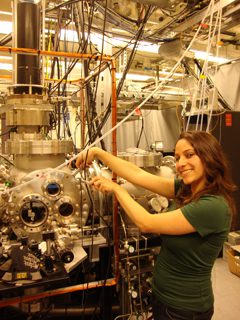
Metalloporphyrins are found in various different organisms ranging from humans to plants. Metalloporphyrins consist of a porphyrin macrocycle with a coordinated metal atom at their center. They are part of many biological systems such as chlorophyll, vitamin B12, cytochrome P-450, and hemoglobin. Synthetic metalloporphyrins are used as commercial dyes and catalysts in the design of solar cells, molecular electronics, and supramolecular building blocks. The metalloporphyrins interaction with light plays a critical role in many systems therefore it is important to characterize the molecules interactions with light. The goal of my […]
Angel Jung

Increasing crop yields has always been a global issue. One of the largest studies of domestic hunger, Hunger in American 2010, reported, hunger is increasing at an alarming rate in the United States (Feeding America). My research this summer focuses on identifying a bHLH gene, ms32, which promotes fertility in maize (corn), the most widely grown grain crop. As the anther – the male reproductive organ in plants – matures during early development, five distinct layers are formed and required for meiosis to function properly. One of the five layers, […]
Maria Pizzano
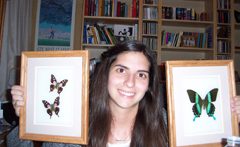
Butterflies are known for the remarkable patterns and colors of their wings. There are precisely arranged rows of microscopic single-cell scales across the wing surface. The color of scales can result from either the biosynthesis of pigments within the scale, or from structural coloration (sometimes both). Structural colors, such as iridescence, are of particular interest because they originate from the interaction of light with complex nanostructures that are found within or at the surface of each scale. A remarkable example of iridescence is seen on the wings of the Gulf […]
Emily Chan
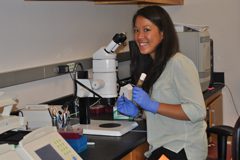
Under the Biological Species Concept, species are defined by the presence of interspecific reproductive isolation, and under this model, both pre-zygotic and post-zygotic reproductive barriers are important in preventing gene flow between populations to drive speciation. My project focuses on pre-zygotic reproductive isolation in the form of courtship songs. In Drosophila athabasca, females from one population are less receptive to the courtship song of males from other populations. I plan to hybridize recently diverged, behaviorally isolated populations of D. athabasca, and use next-generation sequencing techniques to map regions in the […]
Jacob Richards
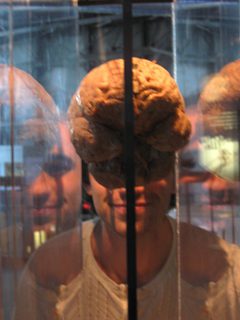
The brain is a system of cells that electrically interact with each other in complex ways. Using functional magnetic resonance imaging (fMRI) on a human at rest or doing a task, we can identify clusters of cells that work together to transmit electrical messages to other clusters of cells. These functional networks allow us to connect what is happening physiologically in the brain to mental phenomena. It is useful to find a baseline organization of functional networks in the brain to characterize what changes occur when a human begins a […]
Derek Shapiro
Not too many people can say they have ever heard of a caecilian, however, these worm-like, tailless amphibians, are an intriguing and understudied organism. For my project, I will be conducting an in depth, observational study of the lung development of one particular species, Dermophis mexicanus. This tropical species has two lungs, similar to other vertebrates, but one distinguishing characteristic is that these lungs are of unequal size. In Dermophis mexicanus, the left lung is significantly smaller than the right lung and the goal of my project is to detail […]
Robert Claus
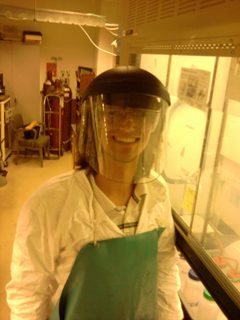
Over the last decade there has been increasing interest in how geckos can walk on vertical and even inverted surfaces. It has been found that they do so with tiny fibers on their feet which bend to adapt to and stick to surfaces. While the basic principles behind this have been studied and replicated on smooth surfaces with very simple fibers, geckos employ complicated fiber structures to adapt to more general surfaces. Due to the complicated nature of the real fibers, research on replicating them fully is progressing slowly. My […]
Yumi Suh
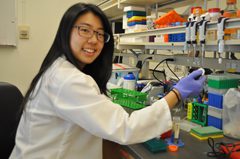
Bacterial communities have been shown to impact everything from geochemical cycles to human health and disease; however, the mechanisms by which natural microbial consortia partition resources and stably maintain cooperative loops of metabolite transfer are very poorly understood. These are incredibly powerful concepts; for example, synthetic communities could represent effective compartments for bioremediation or complex biochemical synthesis. Thus, we propose an exploratory study aimed at developing a genetic interaction map between pairs of model bacteria. Specifically, we will study Shewanella oneidensis MR-1, Zymomonas mobilis ZM4, Desulfovibrio alaskensis G20, and Escherichia […]
Andrew Hwang

Nitric oxide (NO) is a toxic by-product of fossil fuel combustion known to cause lung infection and respiratory allergies. The catalytic reduction of NO by H2 over noble metal catalysts (e.g. platinum, rhodium, and palladium) is an effective means to remove this environmental toxin; however, the reaction mechanism is poorly understood. We aim to develop a set of elementary reaction steps describing the reaction pathway by measuring steady-state reaction rates. We plan to measure isotopic exchange rates and kinetic isotope effects and perform in situ infrared spectroscopy to evaluate the […]
Alyson Cook

The vertebrate skeleton has undergone extensive evolutionary adaption to a wide variety of environments. The precise molecular mechanisms that led to this vast variation are not fully understood. The three spine stickleback fish provides a model organism in which to study these mechanisms. Populations of stickleback colonized newly formed freshwater lakes and streams at the end of the last ice age and repeatedly evolved numerous skeletal adaptations, including lengthening of certain groups of bones. My project will investigate possible genetic and developmental mechanisms that led to this observed variation in […]